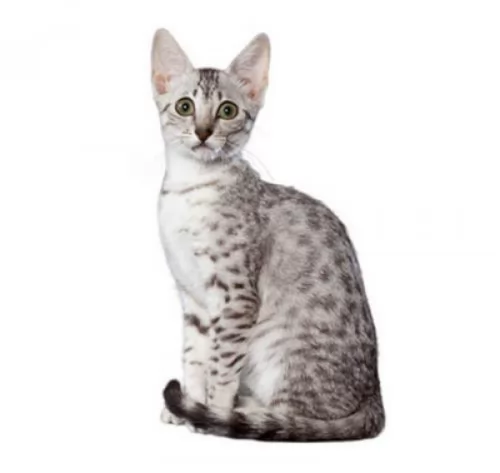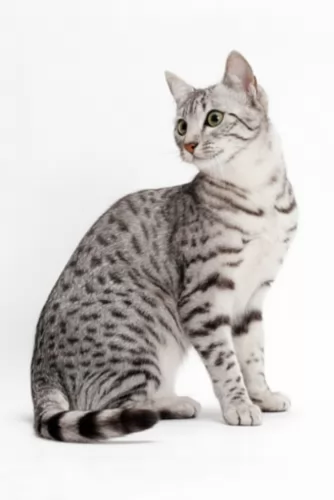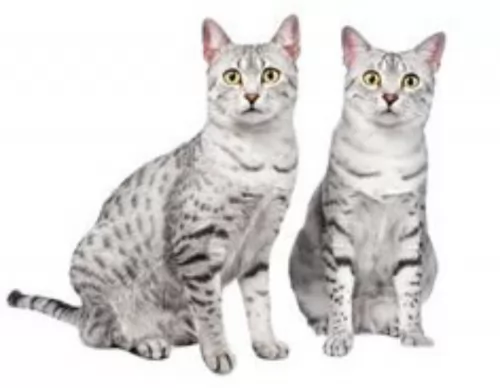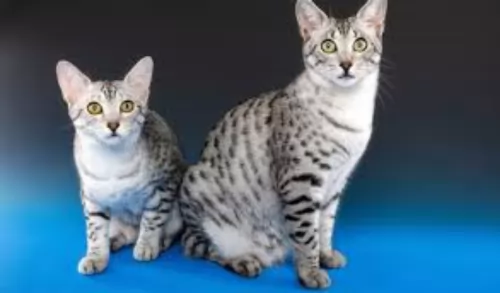 Petzlover
Petzlover Egyptian Mau is originated from Egypt but Persian is originated from Iran. Both Egyptian Mau and Persian are of same weight. Egyptian Mau may live 3 years more than Persian. Both Egyptian Mau and Persian has same litter size. Egyptian Mau requires Low Maintenance. But Persian requires Moderate Maintenance
Egyptian Mau is originated from Egypt but Persian is originated from Iran. Both Egyptian Mau and Persian are of same weight. Egyptian Mau may live 3 years more than Persian. Both Egyptian Mau and Persian has same litter size. Egyptian Mau requires Low Maintenance. But Persian requires Moderate Maintenance
 The Egyptians have always been interested in cats, and it is believed that in 1953 a noblewoman left Egypt with a tabby cat, returning to Italy.
The Egyptians have always been interested in cats, and it is believed that in 1953 a noblewoman left Egypt with a tabby cat, returning to Italy.
Later, another cat was also brought to Italy and the pair were mated. The Egyptian Mau is a natural breed.
In 1956, a kitten of the pair was brought to the United States and the Egyptian Mau was developed. A breeding program was started in the United States. The breed Egyptian Mau was recognized in 1958 in the United States and 1992 in Europe.
 Cat lovers the world over know the Persian cat very well. It's a beautiful long-haired cat breed with its familiar round face and blunt muzzle.
Cat lovers the world over know the Persian cat very well. It's a beautiful long-haired cat breed with its familiar round face and blunt muzzle.
It is not really known when long-haired cats first appeared, or where the Persian originated but their history stems from Persia or Iran as it is known today, where it seems they were first sighted.
The cats were grey-coated and some were white and soon the cats arrived in Britain. They were introduced to the United States in the 1900s. The cat was developed first by the English, and then also by American breeders after the Second World War and the breeding of these cats has also meant a lot of coat colors.
 This is a medium-sized, long, athletic cat that is well muscled. It weighs between 3 to 5kg. The Mau is heavily muscled and strong. It has a triangular-shaped head with large almond-shaped eyes.
This is a medium-sized, long, athletic cat that is well muscled. It weighs between 3 to 5kg. The Mau is heavily muscled and strong. It has a triangular-shaped head with large almond-shaped eyes.
The coat of the Mau is medium in length and is glossy and soft. There are spots on the coat but the cat is particularly well known for the dark stripe that runs from its head to its tail. The coat comes in several different colors such as silver, black, tan and blue. All Maus have green eyes.
These cats are known for being loyal and friendly and they love warm weather and enjoying a spot in the sun.
They are talkative cats too and also love to sit on high perches and survey the world from these high positions. They are excellent climbers and you’ll need to supply these cats with a climbing tree. Its an intelligent breed and he will get along well with children in the home as well as be friendly towards other pets.
 The Persian cat is a medium- to large-sized cat and is heavily boned. He can weigh between 3 and 6kg.
The Persian cat is a medium- to large-sized cat and is heavily boned. He can weigh between 3 and 6kg.
He has stocky legs, a thick neck, small ears, round head, round eyes, and the face is flat or blunt. The kittens are gorgeous balls of fluff.
The coat of the Persian is thick, long, and silky. People many times think only of a white Persian, when in fact the cat comes in many colors and patterns. Eye color for the cat can be blue, green, brown, copper or even odd-eyed.
The Persian isn’t the most active of cats, so attention will need to be given to exercising the cat so as to manage his weight. This cat will also need to have his nutrition controlled to stay in shape and in good health.
Persians enjoy games with their human family and will need some toys to encourage play and exercise.
He is placid and calm but that doesn’t mean he can’t have bursts of energy. They’re quieter than other cats, are sweet-natured, preferring to live in quieter, less boisterous households.
They aren’t loudly vocal but communicate with their eyes and their soft voices. They won’t get on well with small, noisy children but can be loving pets and companions of older children who allow them their own space.
 These are social cats with their own human family but the Egyptian Mau does tend to be a bit reserved around strangers.
These are social cats with their own human family but the Egyptian Mau does tend to be a bit reserved around strangers.
They make excellent pets and companions and if he is happy, you’ll hear him making little noises to express his contentment.
What also makes him so attractive as a pet is that he is a short-coated cat that is considered to be low maintenance.
Before you decide to take on any animal as a pet and before you bring the Egyptian Mau into your home, do thorough research on this rare cat breed. If you do decide to take him in, find out all you can on how to provide for him so that he receives the best care and love in your home.
 The amicable personality of the Persian cat makes it easy to have these cats in your home. The long hair becomes a bit of an issue as the cat sheds quite a bit.
The amicable personality of the Persian cat makes it easy to have these cats in your home. The long hair becomes a bit of an issue as the cat sheds quite a bit.
They’re sweet, quiet cats and they don’t demand attention from you. They are more than happy just lying quietly in a warm spot. They are calm, loving cats and it's no wonder that they are still such a popular breed of cat.
 Egyptian Maus are strong, robust cats and they don't have any particular health problems.
Egyptian Maus are strong, robust cats and they don't have any particular health problems.
Obesity is a major disease with this cat and all other cats and it's worth noting, as obesity contributes to a great number of illnesses in cats. Excess weight can lead to diabetes and arthritis and well as other life-threatening diseases.
Two things that play an important role in his health are ensuring that he has access to excellent, nutritious, meaty food, as cats are carnivores.
You also want to ensure that he gets all his vaccines and de-wormings. If you notice that your cat seems to be under the weather, get him to the vet as soon as possible.
 The structure of this cat’s head can mean some health problems. Hereditary Polycystic kidney disease is prevalent with the Persian cat. It is an inherited condition that causes cysts to form in the kidneys. These cysts are actually present from birth, growing larger over time and interfering with kidney function and ending in kidney failure.
The structure of this cat’s head can mean some health problems. Hereditary Polycystic kidney disease is prevalent with the Persian cat. It is an inherited condition that causes cysts to form in the kidneys. These cysts are actually present from birth, growing larger over time and interfering with kidney function and ending in kidney failure.
Also, with a larger breed cat such as the Persian, hip dysplasia is a problem.
Persians are also susceptible to malocclusion which means ‘incorrect bite’. This particular condition can affect the cat’s ability to grasp and actually hold food. So much so in fact, that now pet food manufacturing companies have even developed specially-shaped kibble to cater particularly for the Persian.
 The beautiful coat of the Egyptian Mau is easy to care for and a weekly brushing will ensure it stays shiny and healthy.
The beautiful coat of the Egyptian Mau is easy to care for and a weekly brushing will ensure it stays shiny and healthy.
If he will let you, try to look inside his mouth to ensure the teeth and gums are healthy.
Remember, if there are any grooming activities for this cat that you feel you can’t cope with, professional groomers will do it for you.
Provide your Egyptian Mau with a climbing tree and scratching post as the cat loves to jump and climb.
He is an active, intelligent cat and needs to be stimulated with exciting toys, particularly when you’re not around to entertain him.
Cats such as the Egyptian Mau are clean and they want their litterbox to be kept clean. Invest in scoop and rake and rid the litter box every day of cat droppings. There also comes a time when you will have to replace all the sand or grit as well.
It will be fantastic if you can provide this cat with a water fountain and a type of pool as they love playing in water.
Make sure your Mau has constant access to fresh, cool drinking water.
 The Persian cat’s coat is long and silky and because he is a fairly heavy shedder, he will require regular brushing – certainly once or twice a week to get rid of that loose hair. It is important to brush and also cut the hair so as to get rid of the tangled knots that form.
The Persian cat’s coat is long and silky and because he is a fairly heavy shedder, he will require regular brushing – certainly once or twice a week to get rid of that loose hair. It is important to brush and also cut the hair so as to get rid of the tangled knots that form.
While brushing your Persian, make sure that his eyes and nose are clear. This is important because the flat face creates problems with these cats.
Excellent cat food for your Persian involves reading labels and understanding what brands are best for your beautiful cat. The Persian cat is a carnivore and will require high-quality food rich in protein.
Speak to your vet if you are in any doubt about the best food for your cat’s health and wellbeing. Make sure your pet has a constant supply of fresh, cool water.
Make sure to keep the litter box clean. Buy a small rake from the pet shop and rake up your cat's feces every single day and dispose of them.